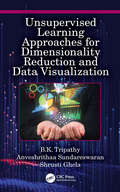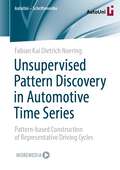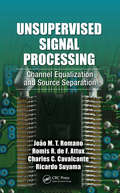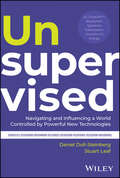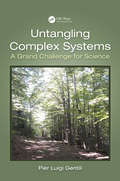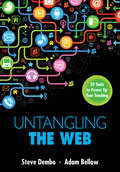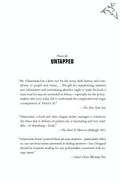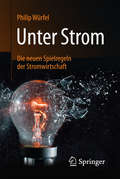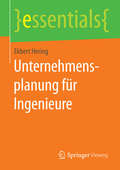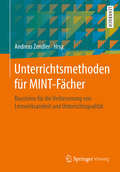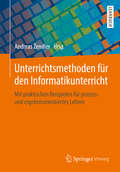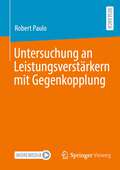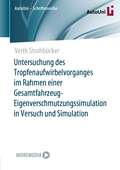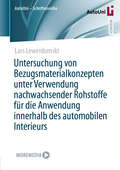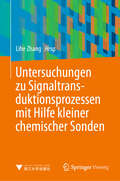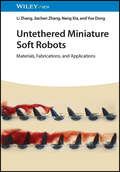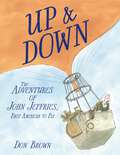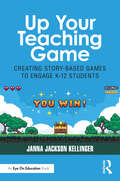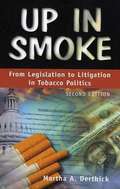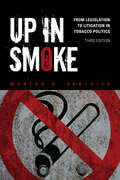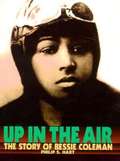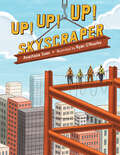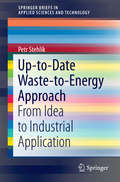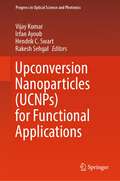- Table View
- List View
Unsupervised Learning Approaches for Dimensionality Reduction and Data Visualization
by B.K. Tripathy Anveshrithaa Sundareswaran Shrusti GhelaUnsupervised Learning Approaches for Dimensionality Reduction and Data Visualization describes such algorithms as Locally Linear Embedding (LLE), Laplacian Eigenmaps, Isomap, Semidefinite Embedding, and t-SNE to resolve the problem of dimensionality reduction in the case of non-linear relationships within the data. Underlying mathematical concepts, derivations, and proofs with logical explanations for these algorithms are discussed, including strengths and limitations. The book highlights important use cases of these algorithms and provides examples along with visualizations. Comparative study of the algorithms is presented to give a clear idea on selecting the best suitable algorithm for a given dataset for efficient dimensionality reduction and data visualization. FEATURES Demonstrates how unsupervised learning approaches can be used for dimensionality reduction Neatly explains algorithms with a focus on the fundamentals and underlying mathematical concepts Describes the comparative study of the algorithms and discusses when and where each algorithm is best suitable for use Provides use cases, illustrative examples, and visualizations of each algorithm Helps visualize and create compact representations of high dimensional and intricate data for various real-world applications and data analysis This book is aimed at professionals, graduate students, and researchers in Computer Science and Engineering, Data Science, Machine Learning, Computer Vision, Data Mining, Deep Learning, Sensor Data Filtering, Feature Extraction for Control Systems, and Medical Instruments Input Extraction.
Unsupervised Pattern Discovery in Automotive Time Series: Pattern-based Construction of Representative Driving Cycles (AutoUni – Schriftenreihe #159)
by Fabian Kai NoeringIn the last decade unsupervised pattern discovery in time series, i.e. the problem of finding recurrent similar subsequences in long multivariate time series without the need of querying subsequences, has earned more and more attention in research and industry. Pattern discovery was already successfully applied to various areas like seismology, medicine, robotics or music. Until now an application to automotive time series has not been investigated. This dissertation fills this desideratum by studying the special characteristics of vehicle sensor logs and proposing an appropriate approach for pattern discovery. To prove the benefit of pattern discovery methods in automotive applications, the algorithm is applied to construct representative driving cycles.
Unsupervised Signal Processing: Channel Equalization and Source Separation
by João Marcos Romano Romis Attux Charles Casimiro Cavalcante Ricardo SuyamaUnsupervised Signal Processing: Channel Equalization and Source Separation provides a unified, systematic, and synthetic presentation of the theory of unsupervised signal processing. Always maintaining the focus on a signal processing-oriented approach, this book describes how the subject has evolved and assumed a wider scope that covers several topics, from well-established blind equalization and source separation methods to novel approaches based on machine learning and bio-inspired algorithms.From the foundations of statistical and adaptive signal processing, the authors explore and elaborate on emerging tools, such as machine learning-based solutions and bio-inspired methods. With a fresh take on this exciting area of study, this book: Provides a solid background on the statistical characterization of signals and systems and on linear filtering theory Emphasizes the link between supervised and unsupervised processing from the perspective of linear prediction and constrained filtering theory Addresses key issues concerning equilibrium solutions and equivalence relationships in the context of unsupervised equalization criteria Provides a systematic presentation of source separation and independent component analysis Discusses some instigating connections between the filtering problem and computational intelligence approaches. Building on more than a decade of the authors’ work at DSPCom laboratory, this book applies a fresh conceptual treatment and mathematical formalism to important existing topics. The result is perhaps the first unified presentation of unsupervised signal processing techniques—one that addresses areas including digital filters, adaptive methods, and statistical signal processing. With its remarkable synthesis of the field, this book provides a new vision to stimulate progress and contribute to the advent of more useful, efficient, and friendly intelligent systems.
Unsupervised: Navigating and Influencing a World Controlled by Powerful New Technologies
by Daniel Doll-Steinberg Stuart LeafHow a broad range of new immensely powerful technologies is disrupting and transforming every corner of our reality—and why you must act and adapt Unsupervised: Navigating and Influencing a World Controlled by Powerful New Technologies examines the fast-emerging technologies and tools that are already starting to completely revolutionize our world. Beyond that, the book takes an in-depth look at how we have arrived at this dizzying point in our history, who holds the reins of these formidable technologies, mostly without any supervision. It explains why we as business leaders, entrepreneurs, academics, educators, lawmakers, investors or users and all responsible citizens must act now to influence and help oversee the future of a technological world. Quantum computing, artificial intelligence, blockchain, decentralization, virtual and augmented reality, and permanent connectivity are just a few of the technologies and trends considered, but the book delves much deeper, too. You’ll find a thorough analysis of energy and medical technologies, as well as cogent predictions for how new tech will redefine your work, your money, your entertainment, your transportation and your home and cities, and what you need to know to harness and prosper from these technologies. Authors Daniel Doll-Steinberg and Stuart Leaf draw on their decades of building and implementing disruptive technologies, investing and deploying funds, and advising business leaders, governments and supranational bodies on change management, the future of work, innovation and disruption, education and the economy to consider how every area of our lives, society, economy and government will likely witness incredible changes in the coming decade. When we look just a bit further into the future, we can see that the task facing us is to completely reinvent life as we know it—work, resources, war, and even humanity itself will undergo redefinition, thanks to these new and emerging tools. In Unsupervised, you’ll consider what these redefinitions might look like, and how we as individuals, and part of society, can prevent powerful new technologies from falling into the wrong hands or be built to harm us. Get a primer on the foundational technologies that are reshaping business, pleasure, and life as we know it Learn about the lesser known, yet astonishing, technologies set to revolutionize medicine, agriculture, and beyond Consider the potential impact of new tech across business sectors—and what it means for you Gain the knowledge and inspiration you need to harness your own power and push the future in the direction of good for all of us not just the few Explore the best ways to invest in the changes these technologies of the future will bring about This is a remarkably thorough and comprehensive look at the future of technology and everything it touches. Shining a light on many unsupervised technologies and their unsupervised oligarchy of masters.
Untangling Complex Systems: A Grand Challenge for Science
by Pier GentiliComplex Systems are natural systems that science is unable to describe exhaustively. Examples of Complex Systems are both unicellular and multicellular living beings; human brains; human immune systems; ecosystems; human societies; the global economy; the climate and geology of our planet. This book is an account of a marvelous interdisciplinary journey the author made to understand properties of the Complex Systems. He has undertaken his trip, equipped with the fundamental principles of physical chemistry, in particular, the Second Law of Thermodynamics that describes the spontaneous evolution of our universe, and the tools of Non-linear dynamics. By dealing with many disciplines, in particular, chemistry, biology, physics, economy, and philosophy, the author demonstrates that Complex Systems are intertwined networks, working in out-of-equilibrium conditions, which exhibit emergent properties, such as self-organization phenomena and chaotic behaviors in time and space.
Untangling Complexity—Peace Building Engineering: Systems Thinking & Complexity Management to Support Community Development (Synthesis Lectures on Engineers, Technology, & Society #29)
by Camilo Andrés Navarro ForeroThis book examines how the rapid acceleration and interconnection of globalization comes with the need for more flexible and adaptable solutions to complex problems and solutions. It describes and demonstrates possible combinations of methods and methodologies to address the complex problems that the world offers us today. Sharing meaningful experiences of the application of workshops in mixed public private companies and with vulnerable communities and peacebuilding communities. The text offers readers, who are looking for tools to face complexity and enhance their projects, real-world examples and accessible methods. The book is based on advanced engineering tools however it is understandable and accessible to a broad audience.This book is for decision makers involved with social complex systems who are uncertain about how they should start and proceed. Discussions on new methodologies to support engineering interventions with communities are being shown. A new multi-methodology proposal called “Complexity Funnel Methodology” (CFM) dissected in “Social Transformation Workshops” (STW) is provided and discussed. It is used with combinations of different methods and methodologies of critical Systems thinking. The implementation of this methodology is described using a case study approach.
Untangling the Web: 20 Tools to Power Up Your Teaching
by Stephen E. Dembo Adam S. BellowTwenty of the best web tools to enrich classroom experiences Few educators have time to find online learning resources that engage and allow students’ creative content expression while meeting core area standards. Discover 20 free tools—flexible enough for kindergarten through high school use—and learn how to leverage technology to transform your classroom. More than a “how-to” guide, you’ll receive access to a web site with videos for richer, in-depth exploration, an online community where you can connect and collaborate with educators, and advice, tips, tricks, and bite-sized anecdotes from ed tech leaders.
Untapped
by John GhazvinianAlthough Africa has long been known to be rich in oil, extracting it hadn't seemed worth the effort and risk until recently. But with the price of Middle Eastern crude oil skyrocketing and advancing technology making reserves easier to tap, the region has become the scene of a competition between major powers that recalls the nineteenth-century scramble for colonization there. But what does this giddy new oil boom mean-for America, for the world, for Africans themselves?John Ghazvinian traveled through twelve African countries-from Sudan to Congo to Angola-talking to warlords, industry executives, bandits, activists, priests, missionaries, oil-rig workers, scientists, and ordinary people whose lives have been transformed-not necessarily for the better-by the riches beneath their feet. The result is a high-octane narrative that reveals the challenges, obstacles, reasons for despair, and reasons for hope emerging from the world's newest energy hot spot.
Unter Strom
by Philip WürfelSpätestens seit der Reaktorkatastrophe von Fukushima ist das Thema Energiewende als generationsübergreifendes Projekt in der breiten Öffentlichkeit angekommen. Dabei reichen die Wurzeln der Energiewende viel weiter zurück. Wer aber kann von sich behaupten, wirklich zu verstehen, worum es jenseits der oberflächlich geführten Pro-Contra-Debatten geht? Die Mechanismen unserer Stromversorgung sind komplex, und populistische Forderungen von Lobbyverbänden erschweren häufig die objektive Meinungsbildung.Philip Würfel bringt mit diesem Buch Licht ins Dunkel. Anschaulich erklärt er die komplexen Zusammenhänge der Energiewirtschaft und vermittelt den revolutionären, auch im Ausland viel diskutierten Umbauprozess der Stromversorgung in Deutschland. Zahlreiche Beispiele aus dem privaten wie beruflichen Alltag bescheren immer wieder „Aha“-Erlebnisse beim Lesen. Die überarbeitete und aktualisierte 2. Auflage ergänzt die 1. Auflage um die sich abzeichnenden Megatrends der Elektromobilität und des Pariser Klimaabkommens.
Unternehmensplanung für Ingenieure (essentials)
by Ekbert HeringDie meisten Ingenieure in der Praxis übernehmen Führungsverantwortung. Dabei ist vor allem die Planungskompetenz gefragt. Es muss einerseits die nahe Zukunft geplant werden, beispielsweise für Umsätze, Ergebnisse und Liquiditäten von Sparten, Produkten und in Märkten für die nächsten drei Jahre. Andererseits ist es erforderlich, zukünftige Entwicklungen des Unternehmens in einem dynamischen Wettbewerbsumfeld zu planen. Diese strategische Planung ist die entscheidende Weichenstellung für den Erfolg der Zukunft. Deshalb werden in diesem Band die Methoden der strategischen und operativen Planung vorgestellt. In einem gesamtheitlichen Rahmen werden die Einzelpläne diskutiert (z. B. Umsatz-, Kosten-, Finanz- und Personalpläne) und ihr zeitlicher Horizont bestimmt sowie der zeitliche Ablauf vorgestellt.
Unterrichtsmethoden für MINT-Fächer
by Andreas ZendlerMathematik, Informatik, Naturwissenschaften (Biologie, Chemie, Physik) und Technik - seit Jahren findet in der breiten Öffentlichkeit eine angeregte Diskussion über diese sogenannten MINT-Fächer statt. Denn das in den MINT-Fächern vermittelte Wissen ist die unverzichtbare Grundlage für die Ausbildung der in Deutschland dringend benötigten Fachkräfte. Darum fordern Politik und Wirtschaft eine stärkere Gewichtung der Fächer, aber auch eine Verbesserung der Unterrichtsqualität. Dieses Buch stellt 20 verschiedene, wissenschaftlich fundierte Methoden für den MINT-Unterricht vor und erläutert die Rolle der digitalen Medien als fächerübergreifendes Element. Die interdisziplinäre Betrachtungsweise bietet Lehrern einen umfassenden Überblick über die verschiedenen Möglichkeiten und Ansätze für den eigenen Unterricht. Für jede der vorgestellten Methoden geben die Autoren wissenschaftliche fundierte Einschätzungen zu ihrer Lerneffektivität und erleichtern so Lehrkräften die Auswahl der geeignetsten Methoden für den eigenen Unterricht. Detaillierte Unterrichtsmodelle helfen bei der Umsetzung in der Praxis. Damit erhalten Lehrer und Lehramtsstudenten einen umfassenden Einblick in die effektivsten Unterrichtsmodelle für ein prozess- und ergebnisorientiertes Lernen in den MINT-Fächern. Dieses Buch lässt sich ideal fächerübergreifend einsetzen und dient dazu, die Lerneffektivität speziell im MINT-Unterricht bei Schülerinnen und Schülern zu verbessern.
Unterrichtsmethoden für den Informatikunterricht
by Andreas ZendlerZu den meisten Unterrichtsfächern findet man heute umfangreiche Standardwerke zum Thema Unterrichtsmethoden, nur für das Fach Informatik existiert keine vergleichbare Literatur. Dabei zeigt ein Blick auf die Bildungspläne aller Bundesländer, dass sich die Informatik als Unterrichtsfach in den Sekundarstufen I und II etablieren wird. Das vorliegende Buch versteht sich als ein Beitrag zur Schließung dieser Lücke in der Informatikdidaktik. Unterrichtsmethoden sind für den Lernerfolg im Unterricht von entscheidender Bedeutung und bilden auch den Dreh- und Angelpunkt dieses Buches. Unterrichtsmethode wird verstanden als klar umrissener, begrifflich herauslösbarer, selbstständiger, wenn auch integrierter Bestandteil des Unterrichts. Als Beispiele für dieses Verständnis von Unterrichtsmethoden werden unter anderem die Vor- und Nachteile des problemorientierten Unterrichts, des entdeckenden Lernens, der Computersimulation, des Frontalunterrichts und der Modellmethode für die Informatikdidaktik erläutert. So entsteht ein Überblick über 20 verschiedene und für den Informatikunterricht relevante Methoden, die anhand von Vorgehensmodellen und konkreten Beispielen für den Einsatz im Unterricht illustriert werden. Außerdem haben Informatiklehrer die verschiedenen Methoden in Hinblick auf ihre Lerneffektivität eingeschätzt. Die Grundlage für dieses erste Übersichtswerk zu Unterrichtsmethoden für den Informatikunterricht bilden verschiedene Forschungsprojekte der Pädagogischen Hochschule Ludwigsburg, die zwischen 2015 und 2018 Daten zu diesem Thema gesammelt haben. Auch dieses wissenschaftliche Fundament macht das Buch zu einer unbedingten Empfehlung für alle (angehenden) Informatiklehrer, die schon lange nach einem Titel mit Unterrichtsmaterialien für den Informatikunterricht gesucht haben.
Untersuchung an Leistungsverstärkern mit Gegenkopplung
by Robert PauloDer in diesem Buch weiterentwickelte Prozess erlaubt eine Optimierung von HF-Leistungsverstärkern zunächst ohne Gegenkopplung mit Hilfe schneller Wechselspannungssimulationen. Ein passendes Parallelnetzwerk, welches verschiedene Parallelgegenkopplungen enthalten kann, wird im Anschluss rein analytisch hinzugefügt. Die Optimierung kann auf Verstärker in einfacher Emitterschaltung, wahlweise mit Kaskodetransistor und mit einer beliebigen Anzahl aufgestapelter Transistoren angewendet werden.Ein weiterer Schwerpunkt ist die Stabilitätsbetrachtung. Es wird gezeigt, wie eine vermaschte Rückführung im Layout eine deutliche Verbesserung der Stabilität bewirkt. Hierfür war eine Erweiterung der klassischen Analyse für die Schleifenverstärkung notwendig.Der Autor führt den Leser durch die analytischen Betrachtungen der einzelnen Schwerpunkte hin zu den simulativen Untersuchungen und verifiziert die Ergebnisse anhand von Messergebnissen gefertigter Verstärkerschaltungen in einer BiCMOS-Technologie. Dem Leser werden zudem beispielhaft sowohl für die Verstärkeroptimierung als auch für die Stabilitätsuntersuchung leistungsstarke Werkzeuge für die Einbettung in eine CAD-Umgebung an die Hand gegeben.
Untersuchung des Tropfenaufwirbelvorganges im Rahmen einer Gesamtfahrzeug-Eigenverschmutzungssimulation in Versuch und Simulation (AutoUni – Schriftenreihe #156)
by Veith StrohbückerIn dieser Arbeit wird im Rahmen einer Fahrzeugeigenverschmutzung eine Untersuchung des Tropfenaufwirbelvorganges an einem Reifen mit numerischen und experimentellen Methoden durchgeführt. Zunächst wird die Tropfenentstehung und das Tropfenfeld eines einzelnen Reifens auf einer wasserbeaufschlagten Rolle in einem Windkanal betrachtet. Anschließend wird über einen neuartigen Ansatz der Tropfenaufwirbelvorgang bei einem einzelnen Reifen direkt simuliert und anhand der erzeugten Versuchsergebnisse validiert. Auf Grundlage des somit entstehenden virtuellen Tropfenfeldes wird eine neue, realistischere Tropfenrandbedingung generiert. Diese neue Randbedingung wird in eine Gesamtfahrzeug-Eigenverschmutzungssimulation implementiert, mit einem klassischen Reifen-Spray-Modell nach dem Stand der Forschung verglichen und realen Verschmutzungsbildern aus Windkanalexperimenten gegenübergestellt.
Untersuchung von Bezugsmaterialkonzepten unter Verwendung nachwachsender Rohstoffe für die Anwendung innerhalb des automobilen Interieurs (AutoUni – Schriftenreihe #173)
by Lars LewerdomskiIn diesem Buch werden drei Bezugsmaterialkonzepte unter Einsatz nachwachsender Rohstoffe untersucht, welche potentielle Alternativen zu konventionell eingesetzten Materialien des Fahrzeuginnenraums darstellen. Die Grundstrukturen bilden ein PVC-Schaumkunstleder, ein Ananasblattfaservliesstoff sowie Flächen bakteriell kultivierter Cellulose. Umgesetzt werden verschiedene Ausführungen der Materialaufbauten mittels labor- sowie großtechnischer Anlagentechnik. Durch die Ermittlung individueller Eigenschaftsprofile nach einer definierten Prüfungsauswahl werden elementare Unterschiede in Abhängigkeit des jeweiligen Ansatzes aufgezeigt und spezifische Optimierungspotentiale für den vorliegenden Anwendungsfall abgeleitet.
Untersuchungen zu Signaltransduktionsprozessen mit Hilfe kleiner chemischer Sonden
by Lihe ZhangIn diesem Buch wird ein umfangreiches Forschungsprogramm zur Erforschung von Signaltransduktionsprozessen mithilfe von Sonden mit kleinen Molekülen vorgestellt. Das Programm wurde von der National Natural Science Foundation of China während des 11. Fünfjahresplans ins Leben gerufen, der im Oktober 2008 begann und Ende 2016 abgeschlossen wurde. Der Bericht fasst zunächst die allgemeinen wissenschaftlichen Ziele und den aktuellen Stand der Signaltransduktionsforschung in China und an der internationalen Grenze zusammen. Basierend auf den neuen Methoden und Technologien, die im Bereich der niedermolekularen Sonden erreicht wurden, veranschaulicht dieses Buch die molekularen Schlüsselereignisse bei Signaltransduktionsprozessen in lebenden Systemen und zeigt die Regulation der Signaltransduktion auf. Dies trägt dazu bei, neue Ideen und Strategien für die Diagnose und Vorbeugung von schweren Krankheiten zu erforschen. Darüber hinaus werden in diesem Buch durch die interdisziplinäre Zusammenarbeit von Biologie und Chemie einige wichtige wissenschaftliche Probleme in der Biologie gelöst und neue Entwicklungen auf diesen Gebieten gefördert. Zu diesen Bereichen gehören die Herstellung von Sonden aus kleinen Molekülen zur Untersuchung der Signaltransduktion und die Entwicklung von Nachweismethoden zur Erfassung von Informationen über die Aktivitäten von Biomakromolekülen. Aufgrund seines Umfangs ist das Buch für Forscher interessant, die in den Bereichen organische Chemie, Naturstoffchemie, medizinische Chemie, analytische Chemie und physikalische Chemie arbeiten. Es fördert auch die multidisziplinäre Zusammenarbeit zwischen Chemie, Medizin, Materialwissenschaft und Biologie.
Untethered Miniature Soft Robots: Materials, Fabrications, and Applications
by Li Zhang Yue Dong Jiachen Zhang Neng XiaUntethered Miniature Soft Robots Reference on achieving contactless manipulation of soft robots, detailing high level concepts and perspectives and technical skills of soft robots Untethered Miniature Soft Robots: Materials, Fabrications, and Applications introduces the emerging field of miniature soft robots and summarizes the recent rapid development in the field to date, describing different types of functional materials to build miniature soft robots, such as silicone elastomer, carbon-based materials, hydrogels, liquid crystal polymer, flexible ferrofluid, and liquid metal, and covering the material properties, fabrication strategies, and functionalities in soft robots together with their underlying mechanisms. The book discusses magnetically, thermally, optically, and chemically actuated soft robots in depth, explores the many specific applications of miniature soft robots in biomedical, environmental, and electrical fields and summarizes the development of miniature soft robots based on soft matter, fabrication strategies, locomotion principles, sensing and actuation mechanisms. In closing, the text summarizes the opportunities and challenges faced by miniature soft robots, providing expert insight into the possible futures of this field. Written by four highly qualified academics, Untethered Miniature Soft Robots covers sample topics such as: Soft elastomer-based robots with programmable magnetization profiles and untethered soft robots based on template-aiding Working mechanisms of carbon-based materials, covering light-induced expansion and shrinkage, and humidity-induced deformation Designing microscale building blocks, modular assembly of building blocks based on Denavit-Hartenberg (DH) matrix, and inverse and forward design of modular morphing systems Material designs of magnetic liquid crystal elastomers (LCE) systems, multiple-stimuli responsiveness of magnetic LCE systems, and adaptive locomotion of magnetic LCE-based robots Controllable deformation and motion behaviors, as well as applications of ferrofluids droplet robots (FDRs), including cargo capturing, object sorting, liquid pumping/mixing, and liquid skin. Providing highly detailed and up-to-date coverage of the topic, Untethered Miniature Soft Robots serves as an invaluable and highly comprehensive reference for researchers working in this promising field across a variety of disciplines, including materials scientists, mechanical and electronics engineers, polymer chemists, and biochemists.
Up & Down: The Adventures of John Jeffries, First American to Fly
by Don BrownThe incomparable Don Brown chronicles the ballooning misadventures of John Jeffries, scientist and aviation pioneer.Swept up by the European ballooning craze of the 1780s, Dr. John Jeffries longed to become the first person to fly across the English Channel. But first he had to outwit a rascally copilot, keep the balloon from bursting, and avoid crashing into the sea. The good doctor's quick-thinking solutions will surprise young readers--and keep them giggling. Orbis Pictus and Sibert Honor winner Don Brown tells this quirky true story with his usual accuracy and heart.
Up Your Teaching Game: Creating Story-Based Games to Engage K-12 Students
by Janna Jackson KellingerUp Your Teaching Game offers K-12 teachers an intuitive and refreshingly fun pathway for creating immersive, story-based games that encourage students to experience the curriculum through play. Regardless of their technical abilities, design acumen, grade level, or domain, today’s teachers have fresh opportunities to create and implement their own content-based games based on the same techniques that video game designers use to create commercial video games. In five actionable steps, this book prepares educators to design curricular games that teach instead of test, that are derived from content rather than divergent from it, and that motivate students to take ownership over their learning. Programs that most teachers are familiar with, such as PowerPoint and Google Slides, and technologies that may be new to them, such as Twine and Scratch, are addressed alongside the use of their own classrooms and schools as game spaces. Novice and veteran teachers alike, as well as curriculum designers and school technologists, will find a wealth of strategies and lessons learned, tips for avoiding pitfalls and time constraints, examples of quests and storyline advancement, and much more.
Up in Smoke: From Legislation to Litigation in Tobacco Politics
by Martha A. DerthickMartha Derthick introduces new evidence from 5 years under the MSA to show that the states were more interested in raising revenue than in improving tobacco control, that the enrichment of wealthy tort lawyers violated the legal profession's ethics.
Up in Smoke: From Legislation to Litigation in Tobacco Politics
by Martha A. DerthickNow, with a brand new 3rd edition, the book returns to "ordinary politics" and the passage of the Family Smoking Prevention and Tobacco Control Act which gave the FDA broad authority to regulate both the manufacture and marketing of tobacco products. Derthick shows our political institutions working as they should, even if slowly, with partisanship and interest group activity playing their part in putting restraints on cigarette smoking.
Up in the Air: The Story of Bessie Coleman
by Philip S. HartPresents the story of Bessie Coleman, an American, who in 1920 traveled to France to become the first black woman to earn a pilot's license.
Up! Up! Up! Skyscraper
by Anastasia SuenSnappy rhymes invite young readers to watch workers dig, pour, pound, and bolt a skyscraper into existence. Simple yet satisfying sidebars provide further information about each step in the construction process. Perfect for preschoolers and all those who dig diggers.Quirky, colorful art enhance the appeal of a construction site with all the equipment and sounds of building.
Up-to-Date Waste-to-Energy Approach
by Petr StehlikPutting forward an up-to-date waste-to-energy approach that combines experience, sophisticated modeling and technical-economic analysis, this book examines the current need for the maximum utilization of energy from waste and the associated environmental impacts. It outlines step-by-step procedures for a complex and original waste-to-energy approach from the idea to its industrial application. With waste incinerators and industrial plants producing large amounts of pollutants, municipalities as well as smaller decentralized operations are beginning to focus on waste research. The principal advantage of utilizing research findings is the ability to apply a complex approach "from idea to industrial implementation" with respect to the needs of the market established by thorough market analysis. This book builds on this concept with an original approach that takes into consideration geographical aspects, the specifics of regions/micro-regions and technological units and/or equipment. Key areas discussed and analyzed in the text include: strategic planning of energy-source locations according to the nature of the respective region or microregion; types and amounts of wastes; logistics etc. using original mathematical models; consideration of on-site processing of various types of waste, taking into account the character of the region (agricultural, industrial etc. ); tailor-made technologies for energy recovery from various types of wastes; implementation of individual technologies with original elements; and support for environmental protection based on advanced flue gas (i. e. off-gas in the case of incineration) cleaning methods.
Upconversion Nanoparticles (Progress in Optical Science and Photonics #24)
by Vijay Kumar Hendrik C. Swart Irfan Ayoub Rakesh SehgalThis book explores upconversion nanoparticles (UCNPs) at both, the fundamental as well as applied levels, for functional applications. It provides a broad perspective about the synthesis approaches of UCNPs with the preferred size, improved and tunable upconversion luminescence, along with the combined multifunctionality for various applications. It highlights the fundamentals and systematic developments in the tuning of UC emission and surface engineering of UCNPs that make UCNPs convenient for use in a large range of applications. Moreover, it gives an understanding of the imposed limitations and challenges associated with these methods to achieve the desired performance in targeted applications. It also includes the latest multifunctional lanthanide-based UCNPs, which efficiently convert low-energy photons into high-energy photons, and their applications in fluorescent microscopy, deep-tissue bioimaging, nanomedicine, optogenetics, solid-state lighting, solar cells, security labeling, and volumetric display.
